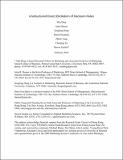| dc.contributor.author | Ding, Min | |
| dc.contributor.author | Hauser, John R. | |
| dc.contributor.author | Dong, Songting | |
| dc.contributor.author | Dzyabura, Daria | |
| dc.contributor.author | Yang, Zhilin | |
| dc.contributor.author | Su, Chenting | |
| dc.contributor.author | Gaskin, Steven | |
| dc.date.accessioned | 2013-09-13T16:44:26Z | |
| dc.date.available | 2013-09-13T16:44:26Z | |
| dc.date.issued | 2011-02 | |
| dc.date.submitted | 2010-02 | |
| dc.identifier.issn | 0022-2437 | |
| dc.identifier.issn | 1547-7193 | |
| dc.identifier.uri | http://hdl.handle.net/1721.1/80727 | |
| dc.description.abstract | We investigate the feasibility of unstructured direct-elicitation (UDE) of decision rules consumers use to form consideration sets. With incentives to think hard and answer truthfully, tested formats ask respondents to state non-compensatory, compensatory, or mixed rules for agents who will select a product for the respondents. In a mobile-phone study two validation tasks (one delayed 3 weeks) ask respondents to indicate which of 32 mobile phones they would consider from a fractional 4[superscript 5]x2[superscript 2] design of features and levels. UDE predicts consideration sets better, across profiles and across respondents, than a structured direct-elicitation method (SDE). It predicts comparably to established incentive-aligned compensatory, non-compensatory, and mixed decompositional methods. In a more-complex (20x7x5[superscript 2]x4x3[superscript 4]x2[superscript 2]) automobile study, non-compensatory decomposition is not feasible and additive-utility decomposition is strained, but UDE scales well. Incentives are aligned for all methods using prize indemnity insurance to award a chance at $40,000 for an automobile plus cash. UDE predicts consideration sets better than either additive decomposition or an established SDE method (Casemap). We discuss the strengths and weaknesses of UDE relative to established methods. | en_US |
| dc.description.sponsorship | Research Grants Council (Hong Kong, China) (SAR (9041182, CityU 1454/06H)) | en_US |
| dc.description.sponsorship | Pennsylvania State University (Smeal Small Research Grant) | en_US |
| dc.language.iso | en_US | |
| dc.publisher | American Marketing Association | en_US |
| dc.relation.isversionof | http://www.marketingpower.com/AboutAMA/Pages/AMA%20Publications/AMA%20Journals/Journal%20of%20Marketing%20Research/TOCs/SUM_2011.1/unstructured_direct_elicitation.aspx | en_US |
| dc.rights | Creative Commons Attribution-Noncommercial-Share Alike 3.0 | en_US |
| dc.rights.uri | http://creativecommons.org/licenses/by-nc-sa/3.0/ | en_US |
| dc.source | MIT web domain | en_US |
| dc.title | Unstructured Direct Elicitation of Decision Rules | en_US |
| dc.type | Article | en_US |
| dc.identifier.citation | Ding, Min, John R. Hauser, Songting Dong, Daria Dzyabura, Zhilin Yang, Chenting Su, and Steven P. Gaskin. "Unstructured Direct Elicitation of Decision Rules." Journal of Marketing Research (2011) 48(1): p. 116-127. | en_US |
| dc.contributor.department | Sloan School of Management | en_US |
| dc.contributor.approver | Hauser, John R. | en_US |
| dc.contributor.mitauthor | Hauser, John R. | en_US |
| dc.contributor.mitauthor | Dzyabura, Daria | en_US |
| dc.relation.journal | Journal of Marketing Research | en_US |
| dc.eprint.version | Author's final manuscript | en_US |
| dc.type.uri | http://purl.org/eprint/type/JournalArticle | en_US |
| eprint.status | http://purl.org/eprint/status/PeerReviewed | en_US |
| dc.identifier.orcid | https://orcid.org/0000-0001-8510-8640 | |
| mit.license | OPEN_ACCESS_POLICY | en_US |
| mit.metadata.status | Complete | |
